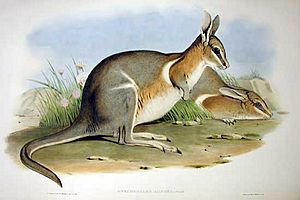Nail-tail wallaby facts for kids
Quick facts for kids Nail-tail wallabies |
|
|---|---|
 |
|
| Crescent nail-tail wallaby | |
| Scientific classification |
|
| Kingdom: | Animalia |
| Phylum: | Chordata |
| Class: | Mammalia |
| Infraclass: | Marsupialia |
| Order: | Diprotodontia |
| Family: | Macropodidae |
| Subfamily: | Macropodinae |
| Genus: | Onychogalea Gray, 1841 |
| Type species | |
| Macropus unguifer Gould, 1841
|
|
| Species | |
Nail-tail wallabies are special animals found only in Australia. They are a type of macropod, which is a group of marsupials that includes kangaroos and regular wallabies. These wallabies get their name from a unique feature: a small, hard "nail" or spur at the end of their tail.
There are three different kinds of nail-tail wallabies. The northern nail-tail wallaby is still common in northern Australia. Sadly, the crescent nail-tail wallaby is now extinct, meaning it no longer exists. The bridled nail-tail wallaby is very rare and endangered, with only about 1100 adults left in the wild. Nail-tail wallabies are generally smaller than many other types of wallabies.
Different Kinds of Nail-Tail Wallabies
There are three main species, or types, of nail-tail wallabies in the Onychogalea group. Each one has its own story:
- Onychogalea fraenata: This is the bridled nail-tail wallaby. Its population and where it lives have shrunk a lot since people first settled in Australia.
- Onychogalea lunata: This was the crescent nail-tail wallaby, also called the warong. It used to be very common across southwest and central Australia. This smallest species quickly disappeared and is now extinct.
- Onychogalea unguifera: This is the northern nail-tail wallaby. It still lives in the Kimberley and Top End areas of Australia.
What Makes Them Special?
Nail-tail wallabies belong to the Macropodidae family. They are small animals that eat plants, also known as herbivores. They are usually quite shy. Early explorers who saw them described their elegant shape, graceful movements, and beautiful markings.
They are named for a very unique feature: a hard, horny point at the very tip of their tail. This "nail" is only about two or three millimeters wide. It's a very unusual characteristic for a mammal. Some people have even compared it to the small bony spur found on a lion's tail.
See also
 In Spanish: Walabís de rabo pelado para niños
In Spanish: Walabís de rabo pelado para niños

